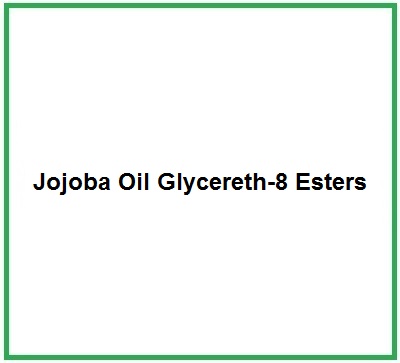Jojoba Oil Glycereth-8 Esters is a chemical compound obtained through a process of esterification of glycerine with the essential oil of Jojoba (Simmondsia Chinensis).
The name describes the structure of the molecule:
- Jojoba Oil is the oil extracted from the seeds of the jojoba plant (Simmondsia chinensis). It's known for its emollient properties and is often used in skincare and haircare products.
- Glycereth-8 indicates a derivative of glycerol that has been ethoxylated with 8 units of ethylene oxide. Ethoxylation makes the molecule more water-soluble and enhances its emulsifying properties.
- Esters are compounds derived from acids (often fatty acids) and alcohols. In this context, it suggests that the ethoxylated glycerol has been esterified with acids present in jojoba oil, making the compound more lipophilic and enhancing its emollient properties.
Raw Materials Used in Production:
- Jojoba Oil: A vegetable oil obtained from the jojoba plant (Simmondsia chinensis). Known for its emollient and protective properties.
- Ethoxylated monoglyceride: This is a glycerol ester that is reacted with ethylene oxide to form ethoxylated esters.
Step-by-step Summary of Industrial Production Process:
- Extraction of jojoba oil. Jojoba seeds are pressed to extract the crude oil.
- Ethoxylation. The monoglyceride is reacted with ethylene oxide under controlled conditions.
- Ester formation. The jojoba oil is then reacted with the ethoxylated monoglyceride to form Jojoba Oil Glycereth-8 Esters.
- Purification. The esters are purified to remove any impurities.
Form and Color.
Jojoba Oil Glycereth-8 Esters appears as a viscous liquid, typically clear or slightly cloudy.

What it is for and where
Cosmetics
Skin conditioning agent - Emollient. Emollients have the characteristic of enhancing the skin barrier through a source of exogenous lipids that adhere to the skin, improving barrier properties by filling gaps in intercorneocyte clusters to improve hydration while protecting against inflammation. In practice, they have the ability to create a barrier that prevents transepidermal water loss. Emollients are described as degreasing or refreshing additives that improve the lipid content of the upper layers of the skin by preventing degreasing and drying of the skin. The problem with emollients is that many have a strong lipophilic character and are identified as occlusive ingredients; they are oily and fatty materials that remain on the skin surface and reduce transepidermal water loss. In cosmetics, emollients and moisturisers are often considered synonymous with humectants and occlusives.
Emulsion stabiliser. Emulsions are thermodynamically unstable. Emulsion stabilisers improve the formation and stability of single and double emulsions. as well as their shelf-life. It should be noted that in the structure-function relationship, the molar mass of the ingredient used plays an important role.
Commercial Applications.
This compound is used in cosmetic and skincare products for its emollient and conditioning properties. It can be found in lotions, creams, serums, and other skincare products.
Cosmetic Industry. Jojoba Oil Glycereth-8 Esters are utilized as emollient and conditioning agents. They help to enhance the feel on the skin and provide moisturizing properties.
Properties. They have the ability to bind water and oils together, enhancing the texture of products. Additionally, they aid in improving the distribution of other ingredients within cosmetic formulas.
Common Applications. They're often found in lotions, creams, conditioners, hair care products, and facial cleansers.
![]() Jojoba oil Glicereth-8 Esters
Jojoba oil Glicereth-8 Esters 


